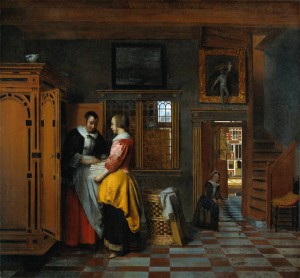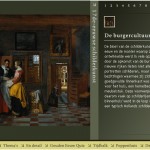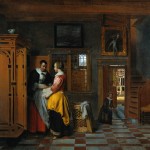Went to the Rijksmuseum a couple of days ago to look at the original ''binnenhuis…
The Linen Closet
 Throug a series of connections too vague to recount I stumbled upon Pieter de Hooch’s Linen Cupboard, 1663. It is in possession of the Rijksmuseum, check their background info on the picture here.
Throug a series of connections too vague to recount I stumbled upon Pieter de Hooch’s Linen Cupboard, 1663. It is in possession of the Rijksmuseum, check their background info on the picture here.
Quote from blogmeridian, where The Linen Closet is connected to Danielewski’s book House of Leaves under the title: Negotiations of Space: “Not all Dutch paintings in this genre are this complex in their depictions of space. But a commonly-held feature of this genre is the simultaneous depiction of an Inside space (the room in the foreground) and an Outside one, visible through an open window or door or gate. The strong sensation is that the viewer doesn’t just stay static, outside the image, but is invited to move into and through the space depicted. And, as I hope you’ll see, this one’s elaborate composition is especially appropriate for comparison purposes to certain textual moments in House of Leaves.
In the first post on this thread, I mentioned the painting’s four vertical spaces, each of them leading us away from the Linen Closet (1). The more I have looked at this painting, the more I realize just how much there is to say about it. But for now I just want to concentrate on the positioning of two figures, the woman holding the stack of sheets and the little girl in semi-shadow standing by the door leading out of the room. Note that each is positioned in such a way that, if they were in the same room, each would have her back to the other. They mirror each other even down to the way each is holding her hands at the waist. Each looks in a different direction, as well: the woman at the Closet, concentrating on her work, and the girl [actually it’s a boy, see info Rijksmuseum] at us, seeming to invite us to join her as she heads out to the street to play. They mirror/echo each other. The upshot: our attention gets pulled in two physical directions simultaneously, but those directions have symbolic charges as well: work/play; maturity/youth. There is also de Hooch’s palette’s visual echoes, too: the goldenrod of the woman’s skirt is perfectly matched by the goldenrod of the light striking the far sidewalk that we can see through the open street entrance of the house. It’s interesting that the goldenrod doesn’t appear on the girl’s dress but, from our perspective, at the height of her shoulder. Meanwhile, look at what we find in the lower center of the painting: a laundry basket with unwashed bedding. For the woman, perhaps it represents unfinished work; for the girl, it might represent something to be escaped–no wonder she leans toward the door.”
This I could use as one of the starting points for my visual research. It has an [order/disorder] [work/play] [adult/child] balance, and it is so feminine.
| « Art as a permission to slow down perception | <-- previous post | next post --> | Ariadne the Minoan priestess » |
|---|







